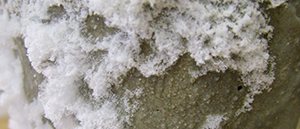You’ve just moved into a condo in a brand new building. You’re parking your car in the below grade garage you just paid extra for, and you notice something on the concrete wall. Upon closer inspection, there is white fluffy stuff everywhere, seemingly coming out of hairline cracks.
What could this be? Time to turn on the Google.
There are three likely causes of white stuff on concrete walls:
 Efflorescence
Efflorescence
- Caused by salt deposits left behind when water seeps through concrete, brick or stone and evaporates
- Not a fungus – will not grow or spread
- Seen more often in older buildings
- Will not grow or appear on surfaces other than concrete
What to do? It sounds like moisture is getting in. A surface applied crystalline waterproofing solution will ensure a dry environment, preventing the growth of our next white substance: Mold
 White Mold
White Mold
- A fungus caused by dampness and poor ventilation often found in below grade areas
- Some common types of white colored mold in homes are penicillium, aspergillus, and cladasporium.
- Can grow on wood or concrete
What to do? All types of mold should be removed regardless of type, as they pose health hazards, and can damage the structure. After removal, the area should be assessed by a waterproofing expert to determine where the moisture is coming from, and how to effectively waterproof the area.
 Crystalline Waterproofing Concrete Additives
Crystalline Waterproofing Concrete Additives
- A by-product of an additive in the concrete used to render the concrete itself permanently waterproof
- The product reacts with water and unhydrated cement particles to create non-soluble crystals to permanently block the pores and capillaries within the concrete matrix
- The product is “Smart”, and will lie dormant throughout the entire life of the concrete structure, only reactivating when and where there is excessive moisture
- These crystals can self-seal cracks up to .5mm, sourcing out any leaks independently
- Many crystalline waterproofing additives (such as Kryton’s Krystol Internal membrane [KIM]) are safe for use with potable water and are non-toxic
- The crystals will only appear on concrete surfaces
- Often appear in newer buildings as settling causes hairline cracks to appear, which along with moisture activate the crystals
What to do? Breathe a sigh of relief knowing your investment is protected from water integration permanently. Common basement issues such as mold and efflorescence are not as likely to occur, as the structure has a high-end, effective mechanism against moisture integration.






